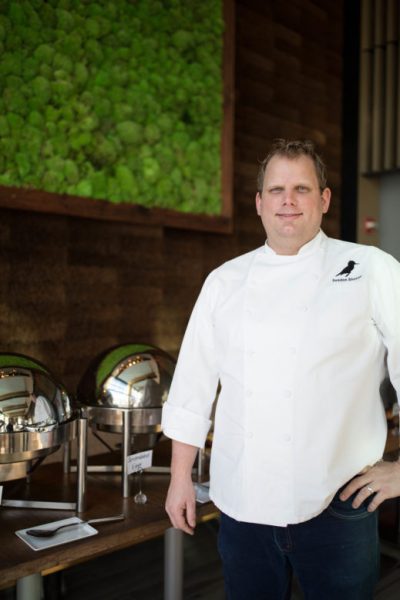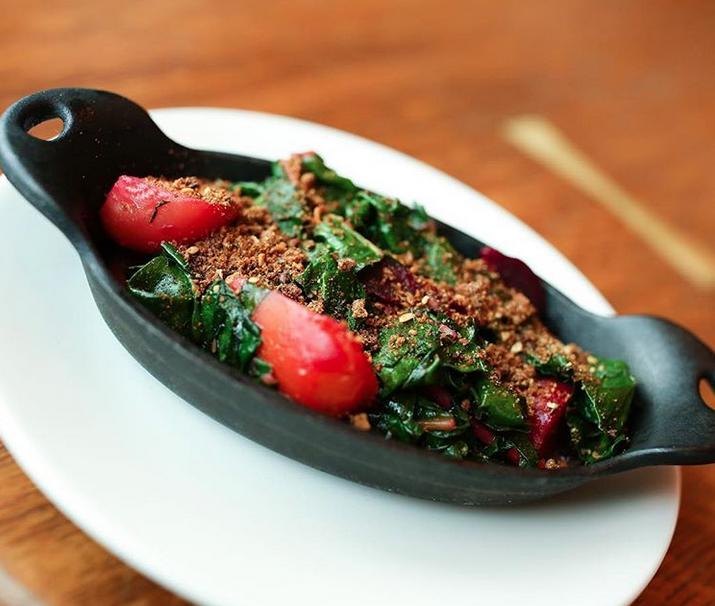
It was only a matter of time before a whole new class of unfamiliar grains joined the ranks of locally-sourced ingredients on restaurant menus. What’s more surprising is how many nutritionally-potent, locally-milled grains are actually available. Witness Nova Scotia native chef Seadon Shouse’s menu at Halifax in Hoboken, where he’s using locally-milled grains with names like eikorn to bring new life to spring dishes. He’s not doing it as part of some local/esoteric ingredient trend; like many chefs, Shouse is inexhaustibly curious about ingredients that can add value (nutritional, textural, flavor) to a dish. Which means less grain-as-starch and more wheatberries, cracked rye berries, eikorn and emmer—both of which are varieties of farro, Italian for “ancient wheat,” and cooked like rice but with more chew and deeper flavor. Since we’re hardly grain experts, we caught up with chef Shouse to get the low-down a new diversity of grains.
Table Hopping: Grains aren’t really a “trend” ingredient. Why diversify? Why now?
Seadon Shouse: Grains are becoming more popular now. I’m seeing a lot more grains on people’s menus, and a lot more local grains on people’s menus. Rather than just having polenta or grits, they’ll say the mill name or the grain area they come from—typically local. It’s the same with flour; more people are using their own local flour for bread. Grains are just amazing. And most people aren’t familiar with the grains you can get, what grains are actually local.
TH: What’s the point of locally-milled?
SS: Freshness. People don’t’ realize the flour and grain you buy in the store could be months old. As soon as you take that grain and break it down into a flour, it starts to go bad right away. It’s important to get your grains milled as fresh as possible. [There are] more nutrients and 100 percent more flavor—a much stronger flavor. For instance, a rye bread [made] with old grains or old flour, it’s not going to have the bright nuttiness that rye usually has.
TH: Are there other advantages to knowing your grain supplier? Can you make special requests, if there’s such a thing in the grain world?
SS: Absolutely. For instance, I use the rye from Castle Valley Mill just over the border in Pennsylvania. I want it coarser than they typically make it. I asked them for a coarser rye and I asked them for cracked rye berries as well—that’s whole rye grains cracked into a couple pieces, not a flour. I use that for my rye bread. They offer the rye berries and the flour, but they didn’t have the cracked rye berries.
TH: Your menu lists “Eikorn Wheat ‘Risotto’” with Barnegat sea scallops. What is eikorn? How do you use it?
SS: Eikorn is one of my favorites. It’s an ancient wheat. I’ve also always been a fan of farro and wheatberries, but I haven’t seen eikorn specifically available in years past. It’s native to this country. It’s also non-GMO. A lot of people that have gluten intolerance can eat eikorn. I get mine through Castle Valley. They’re smaller than wheatberries and they have a nice mild hazelnut flavor, earthier than rice.

Baby beets with swiss chard, dill and rye crumble. Photo courtesy of Halifax
TH: What other unfamiliar grains are you serving? There’s the “Baby Beets with Swiss Chard, Dill, and Rye Crumble,” made with your crumbled house-made rye bread, and also a “Lamb Osso Bucco with Local Cheddar Grits.”
SS: Yes, Blood Butcher Grits. That’s grits made with red butcher corn. It has kind of a lavender color to it, especially when it cooks. All from Castle Valley. They also have spelt, and emmer, but at the moment I’m not using them.
TH: What about seasonality and versatility?
SS: In the winter, in general, I typically use a lot more grains. But grains as a whole are great in salads. Right now, I’m using farro with some strawberries, spring snap peas, a bit of arugula, goat cheese, and balsamic vinaigrette. It’s a little bit less light, a little more hearty. Our scallop dish with the herb pesto uses the eikorn grain with swiss chard and grilled mushroom, almost like a spring risotto. The texture is quite nice. It has a nice chew where rice wouldn’t have as much. And texture is huge.
Really, there’s a lot you can do with grains. Something we’re experimenting with here—it’s not on the menu yet—is a toasted grain pasta. We took eikorn and toasted it in a pan in the oven, to get a little more nuttiness from it. Then we grind it into a flour, add that to a pasta dough and it adds a nice nuttiness to the pasta. And I make a bread crumb out of the rye, which I use as a crumble, for texture.
TH: Is anything about this perfunctory? Do you feel at all constricted?
SS: The whole culinary world in the past five to 10 years has kind of changed. Heavy butters and creams, now it’s a lot lighter. You kind of need to have these lighter items, more health-conscious things on your menu. But I don’t feel constricted. No, I’ve always cooked this way. For me, growing up cooking classical French, yes it was a little heavier. But that really wasn’t ‘my cuisine,’ it was what I was trained with. Cooking light, ingredient-driven food is at the center of what I do.
Halifax is located in the W Hotel at 225 River Street in Hoboken. The current online dinner menu features Rye Oyster Crackers, aforementioned Eikorn Wheat “Risotto,” Local Cheddar Grits, and Rye Breadcrumbs on the Asparagus Gratin (featuring Shouse’s custom cracked rye berries). 201-253-2500
Castle Valley Mill is located in Doylestown, PA. You can purchase their products online, or, on the New Jersey side of the border you can find them at Blue Moon Acres Farm Store in Pennington.
